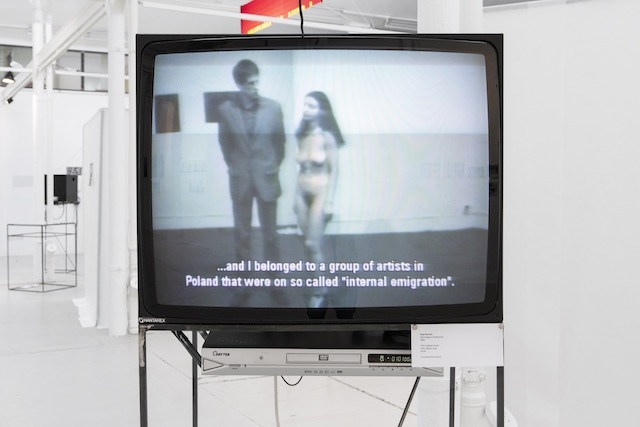How can we connect to past artistic happenings or performances that responded to a specific time and place? A related question: how can we understand an artistic action as political when the circumstances have drastically changed from those in which it was made? The challenge has been taken up by curators in recent decades through exhibitions of documentation in the form of photographs, videos and writings, with varying results: some didactic and dry, others more engaged and interactive. Poetry and Performance: The Eastern European Perspective extends and builds on this tradition through a vast but incomplete combination of the two modes.
Here in its second iteration (following a showing earlier this year at Zilina Synagogue in Slovakia), Poetry and Performance is the result of a multiyear research project at the University of Zurich. Focusing primarily on Soviet-era Poland, Yugoslavia, Czechoslovakia, Russia and Hungary, with a few artists from other former Eastern Bloc countries, it uses original films and writings, photographic and other forms of documentation of performed events, and audio recordings, to compound effect. Bringing together a total of 45 artists, poets and collectives from the socialist era with a few contributions from contemporary practitioners such as Pussy Riot, the show explores how language was deconstructed and poetry used as a form of resistance against the totalitarian system in which these artists operated, and also reveals parallels and links across these socialist countries and even beyond the Iron Curtain.
The exhibition is divided into sections that can more easily facilitate a reading, so to speak, of the displayed works. In ‘Writing–Reading Performance’, Russian artists Lev Rubinstein, Andrei Monastyrski and Dmitri Prigov and Slovak artist Ľubomír Ďurček reflect on the performative character of poetry. ‘Audio Gestures’, meanwhile, recounts how a collective of Czech artists including Václav Havel experimented with recorded sound at a radio studio, highlighting the complex – but not entirely contradictory – relationship between official and underground practices that were tolerated yet surveilled in most of the countries represented here. Poland’s Ewa Partum and the Zagreb-based Group of Six Artists reflect on the body and the relationship to the public space in ‘Interventions in the Public Space’, a section that, unlike the others here, includes highly charged political works critical of their respective contexts, combining work from the 1960s and 70s with contemporary reflections on related themes.
In the 1960s, the performative and ephemeral strategies used by artists to represent the revolutionary social changes taking place in the West were embraced by contemporary artists in the East, as ‘the great thaw’ (aka Khrushchev’s de-Stalinisation policies) allowed a certain freedom of poetic if not concretely critical expression. Poetry and Performance does not clearly separate by nationality despite the specific conditions in which some artists functioned and managed to produce: the artist list does not even mention each artist’s country of origin. Maybe, as the text explains, this was in order to ‘not imply a territorialisation of the topic’. The exhibition architecture, designed by RCNKSK Architekti, is delicate and fragile, paper-covered cubicles inside which films are projected or ephemera displayed. Though there is clearly a connection between the show’s mode of display and its concept, it also feels a little forced. Perhaps the paper falling off the metal frames serves ironically to symbolise the historical fate of the work on show.
While the number of artists in the show is large, and might have been more tightly edited, one wonders why certain countries in the region are not represented. The answer might lie in the fact that the specific conditions prevailing in each state shaped the creative experiments that took place within them, not all of which fit the curators’ parameters. Instead, they prefer to present a more universalising Eastern European perspective.
Poetry and Performance: The Eastern European Perspective at Shedhalle, Zurich, 16 September – 28 October
From the December 2018 issue of ArtReview
